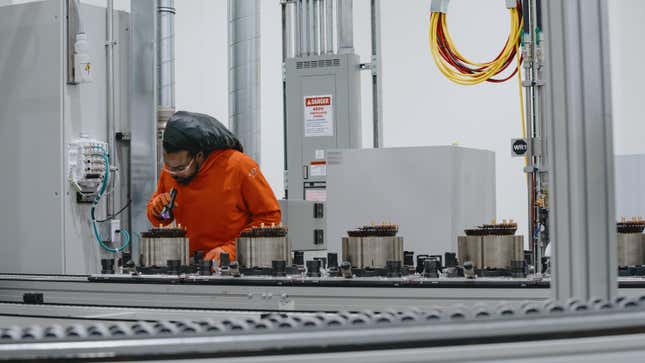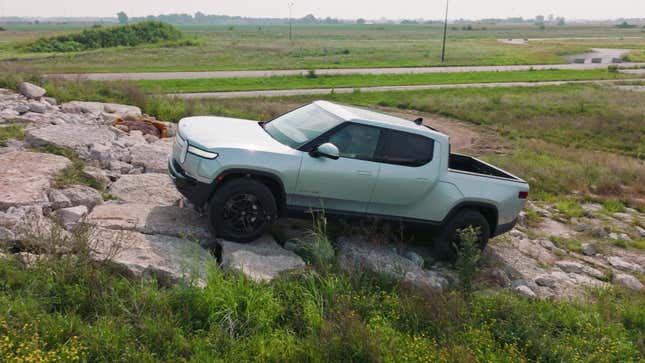Rivian’s Normal, IL Factory Brought Jobs — And Some Housing Chaos

If you walk into a Rivian factory tour expecting something out of the future, where robots buzz around, autonomously building cars in a space-age building, you’re setting yourself up to be disappointed. It’s very much not that. Maybe that’ll be what we see when the second factory opens up outside of Atlanta. But even though Rivian crafts ultra-powerful electric trucks and SUVs and has a strong focus on in-house manufacturing, thousands of robots are arguably not all that necessary.
Rivian Recalls Nearly Every Car It Has Built
(Disclaimer: Rivian wanted me to see its factory so badly, it flew me to Normal, Illinois for a tour. Rivian also paid for breakfast and lunch while I was there. The whiskey I drank at the bar across the street came out of my own pocket because by the time I got in, it was 9:30 pm, and I needed a drink, dammit.)
Instead, Rivian’s Normal, Illinois factory is located in what used to be a Mitsubishi plant. Rivian bought it back in 2017 for $16.5 million, and since then, it has expanded and modernized the facility to the point that it’s now more than four million square feet. There’s also a solar array and a massive wind turbine that combine to generate 2.8 megawatts of power. According to Rivian, that’s enough electricity to allow the electric automaker to charge every vehicle on renewable energy as it leaves the plant.
Photo: Rivian
Four million square feet is a lot of space, but if things go according to plan, Rivian is going to need it. This year, it only expects to build about 52,000 vehicles, which includes the R1T pickup truck and R1S SUV, as well as its electric delivery and service vans. But at full capacity, it should be capable of cranking out 150,000 vehicles a year.
That includes the dual-motor variants of the R1T and R1S. Future models will be built in the Georgia factory that’s currently under construction. And until the R2s go on sale, we expect the dual-motor versions to be the biggest sellers. The quad-motor setup is a neat trick and more capable off-road, but for most people, 533 hp, 610 lb-ft of torque and a 4.5-second zero-to-60 time is going to be plenty.

Photo: Rivian
More importantly, though, with a starting price of $73,000 for the R1T and $78,000 for the R1S, the dual-motor versions are significantly less expensive while still offering a healthy 270 miles of range. They’re certainly not cheap, but $14,000 isn’t exactly chump change even if you’re rich. Additionally, going with the dual-motor setup allows you to add an even bigger battery than the one available on the quad-motor R1T, increasing range to 400 miles. Unfortunately for R1S buyers, at least for now, the so-called Max Pack isn’t available, so they’ll have to settle for “only” 340 miles with the medium battery or 260 miles with the standard one.
Additionally, the dual-motor R1T and R1S can be ordered with a performance package that gives you 665 hp, 829 lb-ft of torque and a zero-to-60 time of just 3.5 seconds. That’s not quite as quick as the quad-motor Rivians, but during back-to-back acceleration demonstrations, it was hard to feel the difference. Maybe those with better-tuned butt dynos can tell that the R1T Performance isn’t as quick, but I have a feeling few others will be able to.

Photo: Rivian
As we toured the facility, it was clear that even though it wasn’t a highly automated space-age factory that would make Elon Musk jealous, it was far from slapped together. It’s about as modern as you can get in an older building, with high levels of organization, tracking and quality monitoring. No one was running around like chickens with their heads cut off. They were just doing their jobs at their stations. In a sense, it was boring — which is exactly what you want in a factory.
But when a new company comes in and hires more than 7,000 people to work at its factory, a lot of times the story is less about the factory itself and more about how those jobs impact the community the factory is in. You get more jobs, but you also get growth, which isn’t always easy for towns and even small cities such as Normal to deal with. So I called up Normal’s major Chris Koos to get a better sense of how the Bloomington-Normal community feels about having Rivian in town.

Photo: Rivian
One thing Koos pointed out early on is that while the economy was pretty good before Rivian showed up, they were still dealing with the effects of another large employer cutting jobs. At one point, State Farm Insurance had employed some 20,000 people, but over the years, that number has dwindled to closer to 13,000. That loss of jobs, combined with the Great Recession, had a bigger impact than Mitsubishi closing the factory and cutting something like 1,000 jobs.
Not that either was great news for the region, especially in an area with only about 125,000 people. But adding more than 7,000 jobs would also have a bigger impact than in a city with millions of people. As you can imagine, it also caused some problems, specifically in the housing market.
“We’re playing catchup,” Koos told me. “We had a housing study done, and it said we were short about 8,000 housing units in the community. There’s a huge demand for multi-family.” And while he pointed out that manufacturing is a regional business, not specifically a local one, he said they’re also seeing Rivian employees commuting in “because the housing just can’t catch up with the need.”

Photo: Rivian
According to Koos, at one point, demand for housing was so high that if you put your house on the market, it would probably sell within 24 hours. And while they’re trying to build more housing, “new housing starts very slow.” Especially when “a lot of the people that were homebuilders, contractors, or subcontractors left the market during that period of downsizing.” According to Koos, “Now everybody’s struggling to catch up.” He later added, “Between Bloomington and Normal, I’d say we’ve approved rezoning of property for multi-family for I’d say 3,000 units. But it’s probably going to be 2.5 years to build that.”
To be fair to Rivian, it’s not entirely responsible for the local housing crunch. Illinois State University is also located in Normal and according to Koos continues to grow as more people are choosing more affordable public universities. This year, the incoming freshman class is likely its largest ever. And where you have more college students, you have more demand for rentals.
While the tight housing market may be frustrating, Koos said locals aren’t complaining much.
“I would say initially there was some concern with Rivian because it was such an unknown. You know that initial skepticism you get when something new,” he said. “Rivian did a community launch to show people what they were doing in the community and that did a lot. Public perception is very pro-Rivian. It’s made a huge impact.”

Photo: Rivian



